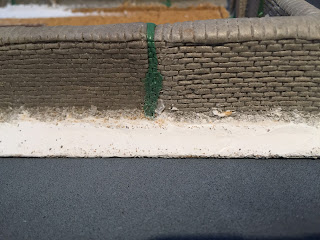One of the things I'm looking forward to doing in my late seventeenth century setting for wargaming is matching up my figures with terrain which looks like coming from the same period and place. As many of you know, this can be a fairly lengthy progress. Terrain gets built up slowly, with new pieces being added each year to the collection.
I've a vague, general plan to work on a set of Flemish terrain boards next year (probably in the Spring), but I'm still enjoying adding specific buildings and terrain features as I'm paint up figures during the course of this Autumn.
I'm particularly hoping to try and create a "feel" for the lost world of 1688 Flanders. I've tried to do this by hunting down town plans from the period. One of the nicest I've seen is the one in this wonderful perspective map of Harderwijk from the 1670s:
I love the way that the buildings have a communal gardened area, frequently furnished with fruit trees. I would imagine that within those enclosed areas, vegetables could be grown and poultry might well be kept. And slightly outside the town buildings, perhaps an old, poorly maintained (and definitely not yet Vauban-improved) town wall, and an open landscape of dykes, poplars and windmills.
The first question is which buildings to use. I've long been a great fan of the 25 mm buildings produced by Hovels in resin. These are now pretty venerable, but have stood the test of time very well. They are little small for modern sized 28mm figures, but fit the Dixon Miniatures and Foundry ranges for the 1680s and 1690s very well. Although resin can be fragile, the "European" buildings range by Hovels in 25mm is pretty robust and fairly adaptable. I'm planning to use the range for most of the Laarden buildings - they seem to catch the right feel and spirit of Flemish towns from the eighteenth and nineteenth century, and I am sure they will do fine for 1688 at a pinch.
The walled enclosures can be made using some of the 25mm walls available from Hovels. These are a bit rough and ready, but nothing that some green stuff can't fill and fix. I doubt that seventeenth century brickwork was universally perfect, especially brickwork used for enclosures and walled gardens.
I've arranged this test terrain piece so that the building stands at the front of a walled enclosure, with plenty of room for a variety of terrain items to be slotted in the back. More on those to come in a later post.
I'm planning some modest gate posts to finish off the front of the enclosure. And of course, with every building, comes a variety of Laarden townsfolk. More of that kind of nonsense to come in later posts.



























